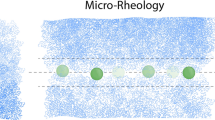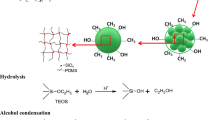Abstract
Hydrogels are an increasingly important class of medical device materials that enable diverse and unique function, but can also be subject to significant biofouling and contamination. Although it is challenging to accurately quantify protein biofouling in hydrogels, spectroscopic detection of fluorescently labeled proteins is one method with the potential to provide direct, sensitive quantitation in transparent materials. Therefore, it is important to understand how fluorophores can affect protein-material interactions in hydrogels. This work uses an independent method, native ultraviolet fluorescence (native UV) of proteins, in conjunction with labeled protein fluorescence and the bicinchoninic acid assay (BCA), to assess the effect of fluorescent labels on protein sorption in polymer hydrogels. Bovine serum albumin (BSA) and lysozyme (LY) were labeled with two common but structurally different fluorophores and used as model biofouling proteins in three contact lens hydrogel materials. Native UV was used to directly measure both labeled and unlabeled protein sorption, while orthogonal measurements were performed with extrinsic fluorescence and BCA assay to compare with the native UV results. Sorption of labeled proteins was found to be <2-fold higher than unlabeled proteins on most protein-material combinations, while differences of up to 10-fold were observed for labeled BSA in more hydrophobic hydrogels. Fluorescence recovery after photobleaching (FRAP) also showed that the fluorescent label chemistry can significantly affect surface adsorption of sorbed proteins on the internal surfaces of hydrogels. This study reveals the complex nature of fluorophore-protein-material interactions and shows the potential of native UV for investigating unlabeled protein biofouling in hydrogels.






Similar content being viewed by others
References
Hoffman AS (2002) Hydrogels for biomedical applications. Adv Drug Deliv Rev 54:3–12
Fernández-Cossío S, Castaño-Oreja MT (2006) Biocompatibility of two novel dermal fillers: histological evaluation of implants of a hyaluronic acid filler and a polyacrylamide filler. Plast Reconstr Surg 117:1789–1796
Nguyen KT, West JL (2002) Photopolymerizable hydrogels for tissue engineering applications. Biomaterials 23:4307–4314
Li L, Chen S, Zheng J, Ratner BD, Jiang S (2005) Protein adsorption on Oligo(ethylene glycol)-terminated alkanethiolate self-assembled monolayers: the molecular basis for nonfouling behavior. J Phys Chem B 109:2934–2941
Donlan RM (2002) Biofilms: microbial life on surfaces. Emerg Infect Dis 8:881–890
Kojic EM, Darouiche RO (2004) Candida infections of medical devices. Clin Microbiol Rev 17:255–267
McDonnell G, Burke P (2003) The challenge of prion decontamination. Clin Infect Dis 36:1152–1154
Deible CR et al (1998) Molecular barriers to biomaterial thrombosis by modification of surface proteins with polyethylene glycol. Biomaterials 19:1885–1893
Tighe BJA (2013) Decade of Silicone Hydrogel Development: Surface Properties, Mechanical Properties, and Ocular Compatibility. Eye & Contact Lens: Science & Clinical Practice January 2013 39, 4–12
Efron N (2010) Contact lens practice. Elsevier Health Sciences, New York
Thomas A, Horbett & John L (1987) Brash. in Proteins at interfaces 343, 1–33 (American Chemical Society)
Andrade JD, Hlady V (1987) Plasma protein adsorption: the big twelvea. Ann N Y Acad Sci 516:158–172
Szott LM, Horbett TA (2011) Protein interactions with surfaces: cellular responses, complement activation, and newer methods. Curr Opin Chem Biol 15:677–682
Phillips K, Cheng Q (2007) Recent advances in surface plasmon resonance based techniques for bioanalysis. Anal Bioanal Chem 387:1831–1840
Keith D, Hong B, Christensen M (1997) A novel procedure for the extraction of protein deposits from soft hydrophilic contact lenses for analysis. Curr Eye Res 16:503–510
Zhao Z et al (2009) Care regimen and lens material influence on silicone hydrogel contact lens deposition. Optom Vis Sci 86:251–259
Brynda E, Drobník J, Vacík J, Kálal J (1978) Protein sorption on polymer surfaces measured by fluorescence labels. J Biomed Mater Res 12:55–65
Casiano-Maldonado M et al (2013) Protein adsorption on thermoplastic elastomeric surfaces: a quantitative mass spectrometry study. Int J Mass Spectrom 354–355:391–397
Lipscomb IP, Sihota AK, Botham M, Harris KL, Keevil CW (2006) Rapid method for the sensitive detection of protein contamination on surgical instruments. J Hosp Infect 62:141–148
Tworkoski E, Dorris E, Shin D & Phillips KS (2014) A high-throughput method for testing biofouling and cleaning of polymer hydrogel materials used in medical devices. Analytical Methods 6:4521–4529
Bingaman S, Huxley VH, Rumbaut RE (2003) Fluorescent dyes modify properties of proteins used in microvascular research. Microcirculation 10:221–231
Teske CA, Schroeder M, Simon R, Hubbuch J (2005) Protein-labeling effects in confocal laser scanning microscopy. J Phys Chem B 109:13811–13817
Wahlgren M, Arnebrant T (1991) Protein adsorption to solid surfaces. Trends Biotechnol 9:201–208
Luensmann D, Jones L (2010) Impact of fluorescent probes on albumin sorption profiles to ophthalmic biomaterials. J Biomed Mater Res B Appl Biomater 94B:327–336
Teale FWJ, Weber G (1957) Ultraviolet fluorescence of the aromatic amino acids. Biochem J 65:476
Timperman AT, Oldenburg KE, Sweedler JV (1995) Native fluorescence detection and spectral differentiation of peptides containing tryptophan and tyrosine in capillary electrophoresis. Anal Chem 67:3421–3426
Chen S, Lillard SJ (2001) Continuous cell introduction for the analysis of individual cells by capillary electrophoresis. Anal Chem 73:111–118
Roegener J et al (2003) Ultrasensitive detection of unstained proteins in acrylamide gels by native UV fluorescence. Anal Chem 75:157–159
Zhang H, Yeung ES (2006) Ultrasensitive native fluorescence detection of proteins with miniaturized polyacrylamide gel electrophoresis by laser side-entry excitation. Electrophoresis 27:3609–3618
Sapan CV, Lundblad RL, Price NC (1999) Colorimetric protein assay techniques. Biotechnol Appl Biochem 29:99–108
Agarwal S, Agarwal A, Buratto L, Apple DJ, Ali JL (2002) Textbook of ophthalmology. Jaypee Brothers Publishers, India
Teale FWJ (1960) The ultraviolet fluorescence of proteins in neutral solution. Biochem J 76:381
Molecular Probes Handbook, A Guide to Fluorescent Probes and Labeling Technologies, 11th Edition. (2010)
Tian F-F et al (2012) The adsorption of an anticancer hydrazone by protein: an unusual static quenching mechanism. RSC Adv 2:501
Wang Z, Song Z, Chen D (2010) Study on the binding behavior of bovine serum albumin with cephalosporin analogues by chemiluminescence method. Talanta 83:312–319
Blakeslee D, Baines MG (1976) Immunofluorescence using dichlorotriazinylaminofluorescein (DTAF). I. Preparation and fractionation of labelled IgG. J Immunol Methods 13:305–320
Mejillano MR, Himes RH (1989) Tubulin dimer dissociation detected by fluorescence anisotropy. Biochemistry 28:6518–6524
Diamandis EP, Christopoulos TK (1996) Immunoassay. Academic, New York
HiLyte Fluor™ 488 acid, SE. at <http://www.anaspec.com/products/product.asp?id=28843>
Jing P, Kaneta T, Imasaka T (2002) Determination of dye/protein ratios in a labeling reaction between a cyanine dye and bovine serum albumin by micellar electrokinetic chromatography using a diode laser-induced fluorescence detection. Electrophor 23:2465–2470
Luensmann D, Heynen M, Liu L, Sheardown H, Jones L (2010) The efficiency of contact lens care regimens on protein removal from hydrogel and silicone hydrogel lenses. Mol Vis 16:79–92
Smith PK et al (1985) Measurement of protein using bicinchoninic acid. Anal Biochem 150:76–85
Olson BJSC, Markwell J (2007) Assays for determination of protein concentration. Curr Protoc Protein Sci Chapter 3, Unit 3.4
Kohnlein J, Glasmacher R, Heide V (2008) Multicentre trial on standardisation of a test soil of practical relevance for comparative and quantitative evaluation of cleaning pursuant to EN ISO 15883. Zentralsterilisation 16:424–435
Kohnlein J, Glasmacher R, Heide V (2009) Multicentre trial on standardisation of a test soil of practical relevance for comparative and quantitative evaluation of cleaning pursuant to EN ISO 15883 description of test procedure. Zentralsterilisation 17:410–415
Johnson AE (2005) Fluorescence approaches for determining protein conformations, Interactions and Mechanisms at Membranes. Traffic 6:1078–1092
Green JA*, Phillips KS*, et al (2012) Material properties that predict preservative uptake for silicone hydrogel contact lenses. Eye & Contact Lens: Science & Clinical Practice November 2012 38, 350–357 * Equal Contributions
Acknowledgments
Dr. Kim Sapsford (FDA) and Center for Devices and Radiological Health.
The mention of commercial products, their sources, or their use in connection with material reported herein is not to be construed as either an actual or implied endorsement of such products by the Department of Health and Human Services.
Author information
Authors and Affiliations
Corresponding author
Rights and permissions
About this article
Cite this article
Guan, A., Li, Z. & Phillips, K.S. The Effect of Fluorescent Labels on Protein Sorption in Polymer Hydrogels. J Fluoresc 24, 1639–1650 (2014). https://doi.org/10.1007/s10895-014-1450-8
Received:
Accepted:
Published:
Issue Date:
DOI: https://doi.org/10.1007/s10895-014-1450-8
Keywords
- Hydrogel
- Fluorophore
- Fluorescent label
- Sorption
- Biofouling
- Protein
- Labeling
- Interference
- Contact lens
- Medical device
- Adsorption
- Absorption
- Fluorescence
- Fluorescence recovery after photobleaching (FRAP)
- Photobleaching
- Intrinsic fluorescence
- UV fluorescence
- Residues
- Microplate
- Structure
- Lysozyme
- Ionic
- Hydrohobic
- BCA assay
- Calibration
- Response
- Transparent
- (Hydroxyethyl) methacrylate (HEMA)
- Silicone
- Bicinchoninic acid
- Polymer




